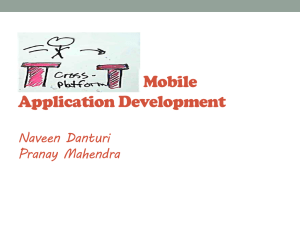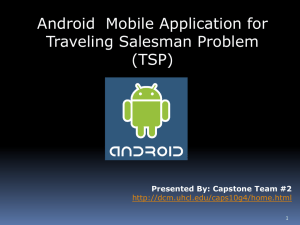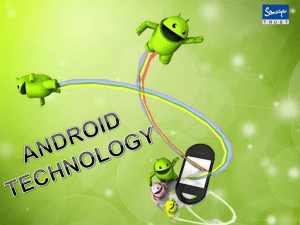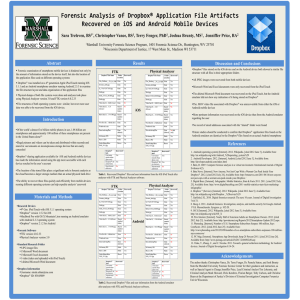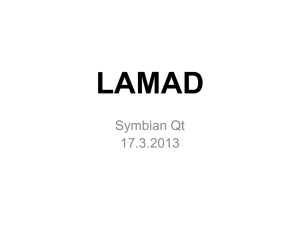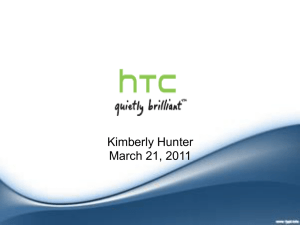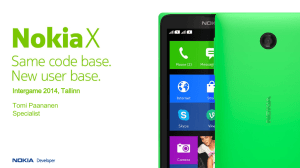Accessing Mobile Technologies:
advertisement
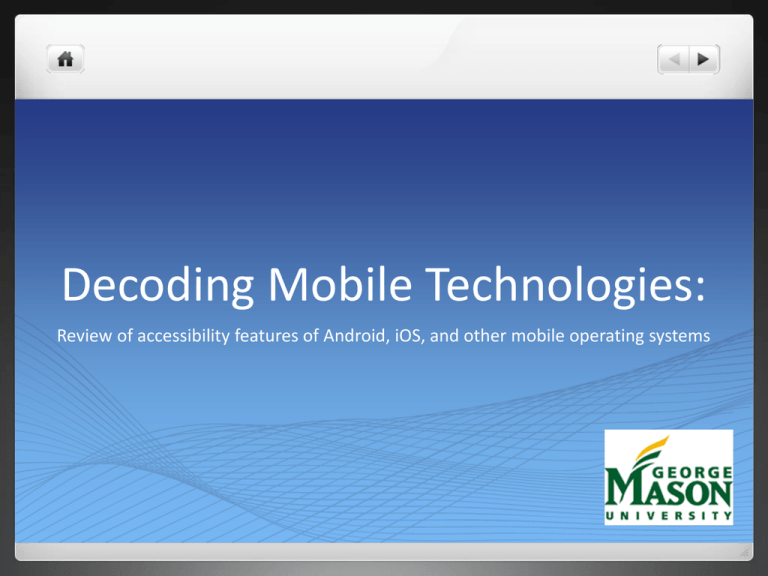
Decoding Mobile Technologies: Review of accessibility features of Android, iOS, and other mobile operating systems Today’s Agenda Introduction What you’ll learn Review of accessibility features available in today’s most popular mobile operating systems Summary Q&A Introduction Korey Singleton, Assistive Technology Initiative Manager Mission of ATI: …provide individuals with disabilities an accessible university environment by supporting access to all technological, architectural, and educational resources available at George Mason University through the incorporation of assistive technologies... More information about us at http://ati.gmu.edu Learning Objectives Learn about the built-in tools/features that enable access to mobile technologies for individuals with disabilities. Discuss the differences and similarities, in terms of accessibility, between the different mobile operating systems. Understand and identify which mobile operating systems provide the greatest level of access to users of a specific disability type (e.g., vision loss). Content Questions In what version of the Android operating system did accessibility start to be incorporated? Oratio for Blackberry is available for most Blackberry smartphone? Which smartphone manufacturer markets the Symbian OS? Which mobile OS’ are supported by Google and Apple, respectively? iOS supports wireless (Bluetooth) refreshable braille displays? Let’s Get Started Understanding the market for mobile technologies Market Penetration (Business) Smartphones now represent more than half of all handheld wireless devices used by corporate wireless users…up 22% from 2010[6] Types of Devices – Business users[6] RIM’s blackberry remains the leading smartphone OS. iPhone is the fastest growing. Blackberry has about 69% market penetration, increasing to 81% among businesses with 1000 or more employees. Inverse is true among smaller companies, there is increased usage of iOS and other mobile operating systems. Market Penetration (Personal Use) TNS Global reports[1]: Evolution of mobile technology has fueled rapid consumer adoption Smartphone penetration among individual wireless households up from 1 in 4 US households in late 2009 to 1 in 3 US households just a year later Most notable uses in US…personal email and text messaging[3] Types of Devices – Personal users[6] RIM’s blackberry remains the leading smartphone OS among personal users as well with about 36% market share. iOS and Android are close behind with about 25% and 24% , respectively. Android is the fastest growing mobile OS in the US among individuals 13 years and older. Future Trends Workplace considerations - According to the IDC, smartphones outsold PCs for the first time in Q4 2010. [4] Higher Education considerations Barnes & Noble campus bookstores recorded a 3000% increase in eTextbook sales in 2010…industry projections forecast 60% of textbook titles available digitally by 2014. [2] Students report lower costs and lighter carrying load as primary reasons for adoption of digital textbooks. [5] General Use - Worldwide tablet sales have exploded in the past year. One of the reasons for that growth is believed to be the adoption of iPads as teaching tools in k-12.[9] Mobile OS Review Android OS, iOS, and others Android Accessibility Important Facts about the Android OS Fastest growing mobile OS in the US[1] All Android versions starting with v1.6 or later have built-in support for speech output and accessibility There are 50+ different types of phones worldwide that are running some version of the Android OS Major problem in terms of accessibility: Android versions are not standardized across all manufacturers, platforms, etc. Depending on model of phone, one user could have v1.6, while another has v2.2 (latest release). Android OS Why is this a problem? User experiences may differ – Carriers and device manufacturers will sometimes create customized versions of the Android OS. For example, HTC ships phones that include a custom user interface called HTC Sense. Samsung, LG, and Motorola could also change the user interfaces if they choose. There is no guarantee that devices with customized Android operating systems include accessibility support. Vision Enabling Basic Accessibility By default, accessibility is turned off. Users with little to no vision will likely require sighted assistance to turn on this feature. Once enabled, however, it will remember the setting. Can be enabled through Menu/Settings/Accessibility Voice Input/output allows for customization of speech settings Vision cont.… Important Note: Certain Android phones may not have Talkback installed. When turning on Accessibility, OS will prompt user to go to Android Market, download and install the application. Check box to turn on Accessibility, then turn on the following: • Talkback – enables speech output • Kickback – enables vibration (haptic feedback) along with speech • Soundback – enables additional sound notifications when activating a control Another Option for Setting Up Accessibility Installer guides from IDEAL Apps4Android Installs several accessibility apps: Eyes Free Suite (Talkback, Kickback, Soundback, Eyes Free Shell, Talking Dialer, Walky Talky, Intersection Explorer) In addition to the Eyes Free Suite, several 3rd party apps like K9 Mail, IDEAL Magnifier, IDEAL Item ID, and IDEAL Web Reader are installed. Another Option for Setting Up Accessibility cont.… Eyes Free Shell – User interface designed to to make it easier for individuals with low vision and blindness to navigate the Android OS Talking Dialer – accessible dialing interface Walky Talky (walking) and Intersection Explorer (auto) – accessible GPS applications 3rd party apps K9 Mail – accessible email application IDEAL Magnifier – basic magnifier using phone’s camera IDEAL Item ID – bar code scanner IDEAL Web Reader – accessible web browser Important Note: User experience depends on the phone model. Individuals with vision loss will likely require sighted assistance in setting up some of the apps. Hearing Basic Features: Notifications Panel – Alerts the user to battery status, incoming emails, SMS messages, voicemail messages, etc. Audible, Visible, and vibrating alerts for all notifications Hearing Aid Compatibility Mode (HAC) Allows user to amplify in-call volume Hearing cont.… • Notable Features: • • Visual Voicemail • Allows you to view all of your voicemails at once, read in order of preference • Control playback Check with carrier for costs: Sprint Voicemail-to-Text transcription costs $1.99/month Hearing cont.… Notable Features: Video Chat and/or Video messages using ‘Qik’ Users have the ability to chat in real-time using front (certain models) or rear-facing cameras Or, send video messages – Can be created on phone and saved to user account at www.qik.com Physical & Motor Basic Features: Tactile Buttons (Power, volume keys, call button, other keys depends on model) Hands-free speakerphone Downloadable, Assignable ringtones Auto-sync (contacts, calendar events, mail) 3rd party apps required to sync podcasts, music, movies, etc.) Physical & Motor Notable Features: Speech-to-text capabilities – Available as a separate app like Voice Search or Voice Dialer, also imbedded in default onscreen keyboard (i.e., Evo 4G) Physical & Motor Notable Features: Swype Keyboard (example shown is Evo 4G) – Alternative keyboard input method where using literally drags finger across keyboard to choose characters Physical & Motor Notable Features: Talkback, Kickback, Soundback – While these features were designed with low vision/blind users in mind, they could be especially useful for individuals with physical/motor difficulties. For example, Talkback can read notifications, emails and messages (with 3rd party support), thus enabling a user to receive certain information without having to pick up the phone. Physical & Motor Notable Features: Long Press – You can use a long press to open menus that are specific to the active item - think of it like opening a context menu on a PC. Examples – 1. Performing a long press on a song in the Music player application in Android 2.2 will open a menu that allows you to add or remove it from a playlist. 2. Long press of the Home key opens the most recently used applications 3. Long press of the Search key opens the Voice Search app Accessible Android Phones[12] T-Mobile G2 (v2.2) LG Ally (v2.1) Samsung Epic 4G (v2.1) Motorola Droid (v2.2) HTC Dream (v1.6) Not so accessible Android Phone – HTC Evo 4G Demo – Android OS Accessibility features previously discussed Demo – HTC Evo 4G vs. Samsung Epic 4G (specific focus on navigation using speech) Review Questions 1. In what version of the Android operating system did accessibility start to be incorporated? 2. Which mobile OS’ are supported by Google and Apple, respectively? Any questions about the Android OS? iOS Accessibility (i.e., iPod, iPhone, iPad) Important Facts about the iOS Arguably, the most exciting mobile OS in the world!! Versions are same across all platforms (i.e., iPod Touch, iPhone, iPad). What does this mean? More uniformity in terms of accessibility No learning curve - If you know how to use one device, it is easy to use another User experiences are the same! Apps that come with OS (i.e. mail, messaging, calendar, contacts, notes, calculator, internet, app store, maps) are accessible Vision VoiceOver – Same gesture-based screen reader that is available on Mac OS Available on the iPad, iPhone 3GS/4G, and iPod Touch Support for up to 21 different languages Very important feature: Can be enabled without sighted assistance using a compatible screen reader and latest version of iTunes Vision cont.… VoiceOver reading features: Voice rate adjustment Rotor adjustment – Text navigation by character/word Speak auto-text Full support for all built-in applications (i.e., Phone, Mail, iTunes, Safari, Maps) Vision cont.… Zoom/Contrast Settings: Very important feature: Can be enabled without sighted assistance using a compatible screen reader and latest version of iTunes Allows full-screen magnification Double tap with 3 fingers instantly zooms in and out 200%. Double tap and drag 3 fingers to adjust magnification between 100% and 500% Reverse video can be used with both Zoom and VoiceOver Vision cont.… Other notable features: Tactile buttons Audible, visible, and vibrating alerts Support for Bluetooth compatible refreshable braille displays. Braille displays with input keys can be used to control iOS Hearing Support for playback of captions (open, closed, subtitles) Instant messaging/chat Apps available in App Store (e.g., AIM, Yahoo. MSN, Google Talk) Multimedia Message Service (MMS) – supports text messages with multimedia attachments TTY Support – requires iPhone TTY adapter Hearing cont.… Audible, Visible, and vibrating alerts Visual Voicemail Allows you to view all of your voicemails at once, read in order of preference Control playback Mono Audio – route both audio channels into each earbud so that you can hear both channels in each ear (very useful for individuals with hearing loss in one ear) Hearing cont.… Notable Features: Video Chat using Facetime Users have the ability to chat in real-time using front-facing cameras on the Mac, iPhone, iPad, or iPod Touch Free for iPhone and iPod touch users, $0.99 in Mac App Store for Mac users Physical & Motor Stereo headset – control music playback, answer/end calls On-screen keyboard with predictive text entry – learns as you type, allow user to increase text input speed over time Physical & Motor cont.… Voice Control Supports 21 different languages Allows user to play music and make phone calls Physical & Motor cont.… Tactile Buttons Hands-free speakerphone Downloadable, Assignable ringtones Auto-sync (music, movies, podcasts, contacts, calendar events, etc.) Physical & Motor cont.… Demo – iPod Touch and iPad 16GB WiFi Review Questions 1. Which mobile OS’ are supported by Google and Apple, respectively? 2. iOS supports wireless (Bluetooth) refreshable braille displays? Any questions about iOS? Other Mobile Operating Systems, Resources, Etc. GARI Project Stands for ‘Global Accessibility Reporting Initiative’ http://www.mobileaccessibility.info GARI Project is a way for manufacturers of mobile devices to provide consumers with disabilities and other limitations with a universal accessibility features database that can be used when learning about what a particular mobile device offers in terms of accessibility. Nokia/Symbian OS Symbian is the mobile OS for all Nokia handsets. As Nokia is the leader in smartphone market share (~36%) worldwide[8] and it is popular everywhere…except in the US. Nokia/Symbian OS cont.… Nokia emphasizes accessibility! http://www.nokiaaccessibility.com Member of the Global Accessibility Reporting Initiative (GARI) Project – http://www.mobileaccessibility.info Nokia/Symbian OS cont.… Vision 3rd party Text-to-speech available using Nuance Talks & Zooms or Mobile Speak ($89) Mobile Speak demo Nokia/Symbian OS cont.… Vision Nokia TTS Reader Reads text messages, multimedia messages, and emails Available on compatible Nokia Series 60 phones Nokia Magnifier ($89) Uses existing camera functionality Available on compatible Nokia Series 60 phones Nokia/Symbian OS cont.… Hearing Lower RF emissions for hearing aid compatibility Most models are compatible with TTYs Nokia Wireless Loopset for hearing aid users Newer Nokia E5 handset comes with Mobile Captions Service preinstalled – allows user to receive captions directly on their cell phone Nokia/Symbian OS cont.… Mobility Dished keys to make it easier to use a mouthstick or other device to dial Audio/voice interaction with user interface eliminating need to see or grasp phone Speakerphone with voice-activated answering Speech-independent name dialing Voice dialing, voice recorder, and voice commands with integrated hands-free speaker Bluetooth functionality Eyelets for connecting lanyards Nokia/Symbian OS cont.… Cognition Dial-out buffer memory allowing for more time to complete a process Phone books with images for easy identification Audio, visual or vibrating alerts Keys provide audio, visual and tactile feedback when pressed Pre-recorded voice commands to control phone functions Distinct sounds and on-screen icons alert you to network strength and battery level Friendly screen layouts Familiar language and descriptive icons Functionality that’s consistent from screen to screen, menu to menu Help menus designed to anticipate the information being sought Keypad shortcuts to make every step quick and efficient Other Tools available for Symbian OS Mobile Magnifier ($89) Magnification levels from 1.25x to 16x Can be used with or without speech Font-smoothing for easier readability Three different layouts: full-screen, split and distributed view Different color schemes, including inverted color Automatic panning and cursor-tracking Automatic zoom function that detects areas of interest on the screen Works with Windows Mobile and Symbian OS Available through AT&T Partnership Other Tools available for Symbian OS cont… Mobile Speak ($89) Make and receive calls, emails, text messages. Manage your contacts and call lists. Review the numbers entered in the dialer screen, and check the caller ID on incoming calls. Browse the Internet. Manage the calendar to schedule appointments and keep track of them using alarms and reminders. Create text and voice notes. Perform calculations. Listen to music and podcasts. Configure phone settings, profiles and ringtones, speed dial keys and voice tags. Share data between your device and other mobile phones and computers. Works with Windows Mobile and Symbian OS Available through AT&T Partnership Nokia/Symbian OS cont.… AT&T Partnership Started in 2007, AT&T customers can purchase a supported Symbian Series 60 or Windows Mobile Standard smartphone with a Code Factory screen reader or screen magnification application from AT&T. Currently supported devices (taken from AT&T website): Nokia Surge™(6790) Nokia E71x Nokia/Symbian OS Updates Current State: Until this year, Symbian was the primary OS for all Nokia handsets. As Nokia is the leader in smartphone market share worldwide[8], it is popular everywhere…except in the US. Until Sept. 2010, the Symbian OS was sold primarily on Nokia and Sony-Ericsson handsets. Since that time, Sony-Ericsson has adopted Android[7] and Nokia has partnered with Microsoft to market Windows Mobile 7[8] as their primary mobile OS. Nokia/Symbian OS Updates cont… What does this mean for Symbian’s future? Not entirely sure right now. There are still millions of Symbian users out there worldwide and many more phones that will still be sold. However, it seems to have very little future of ever gaining a foot hold in the US Market. Windows Mobile OS Recently released version – Windows Phone 7 (WP7) Microsoft started over – This version was a complete rework of the Windows Mobile platform As a result, none of the applications that ran on previous versions will run on this one. Different levels of accessibility expected – Similar to Android, the OS will be supported by major manufacturers like HTC, Samsung, LG, Dell, Nokia, and LG. Windows Mobile OS cont.… There are basic accessibility features: Speakerphone, Bluetooth, Phone books with images for easy identification, Audio/visual/vibrating alerts, SMS messaging, IM, predictive text, gesture support, and other features that may depend on the model of the phone Most Notable features: “Live Tiles” – Offers friendly home screen with large tiles/pictures, large print notifications (i.e., email, messaging, social media, etc.). The ability to pin contacts, apps, etc. to the home screen makes for easier navigation. Windows Mobile OS cont.… More Notable features: TTY Support Speech recognition support for making calls, searching the web, or opening applications Windows Mobile OS cont.… Windows Mobile 6.5 Windows Mobile 6.5 is still available on some newer model phones (.e., HTC Touch Pro 2 from Sprint, HTC Imagio from Verizon, Samsung Jack from AT&T). Older models still enjoy some support as well. This version of Windows Mobile was considered to be very accessible. Required 3rd party apps like Mobile Speaks and Mobile Magnifier to provide full access to the OS for individuals with low vision and blindness Important Note: Support timeline?? Blackberry OS Blackberry Accessibility mentions many of the same features that support access to their products for individuals with disabilities (i.e., vision, hearing, mobility, cognitive). Most notable features: Physical keyboards, Tactile buttons Audible, visible, and vibrating alerts Contrast settings, etc. Text messaging (SMS or MMS) Support for closed and/or open captioned multimedia (select Blackberry models) Predictive text, auto-text Shortcut keys Voice notes, voice dialing 3rd party text-to-speech with Oratio (Humanware, Inc.) • • • • • • Manage instant messaging, emails, SMS and MMS. Make and receive calls with access to caller ID on incoming calls. Manage contacts and call log. Schedule appointments and tasks with alarms and reminders. Access to the phone's settings, ring tones and speed dials. Only available on Blackberry Curve 8250 smartphone from AT&T [10] Clarity Theme for Blackberry Smartphones • Available for free from Blackberry App World • Simplified, easy-to-use Home screen interface • Large, text-only icons on the Home screen • High-contrast screen displayed in dark on light or light on dark • Clickable header that allows you to easily switch between Date and Time or Battery and Network level views Review Questions 1. Oratio for Blackberry is available for most Blackberry smartphone? 2. Which smartphone manufacturer markets the Symbian OS? Any questions about any of the other mobile OS’ that we just covered? Summary Trends Most in mobile technology popular mobile OS’ Blackberry (workplace) Android OS (personal/business) iOS (personal) Most Accessible?? References 1. Android fastest growing smartphone OS in U.S., survey finds - Computerworld. (n.d.). . Retrieved May 7, 2011, from http://www.computerworld.com/s/article/9199499/Android_fastest_growing_smartphone_OS_in_U.S._survey_fi nds 2. E Textbooks A Fast Growing Trend For Entrepreneurs And Tablet Makers - Pressed - Portfolio.com. (n.d.). . Retrieved May 8, 2011, from http://www.portfolio.com/views/blogs/pressed/2011/02/25/e-textbooks-a-fastgrowing-trend-for-entrepreneurs-and-tablet-makers/ 3. Mobile Trends: Smartphone Usage and Penetration in Latin America and the United States | Antonio Altamirano. (n.d.). . Retrieved May 7, 2011, from http://www.altamirano.org/mobile-technology/smartphones-penetrationusa-latin-america/ 4. Smartphones Outsell PCs. (n.d.). . Retrieved May 7, 2011, from http://www.readwriteweb.com/archives/smartphones_outsell_pcs.php 5. The Future is Here: e-Textbook Sales Increase 3000 Percent | Barnes & Noble College News. (n.d.). . Retrieved May 8, 2011, from http://www.bncnews.com/the-future-is-here-e-textbooks-grow-3000-percent References cont.… 6. TNS survey: Smartphones gain traction for both businesses and consumers. (n.d.). . Retrieved May 7, 2011, from http://www.tnsglobal.com/news/news-EBE5DD9AE77B4A09AB7FA6B1AF0E4BE2.aspxIDC smartphone shipment figures for Q1 2011 - All About Symbian. (n.d.). . Retrieved May 10, 2011, from http://www.allaboutsymbian.com/news/item/12858_IDC_smartphone_shipment_figure.php 7. Sony-Ericsson Chooses Android Over Symbian: So What?: Tech News and Analysis «. (n.d.). . Retrieved May 10, 2011, from http://gigaom.com/2010/09/27/sony-ericsson-chooses-android-over-symbian-sowhat/ 8. Why Nokia can’t crack the U.S. market - Sep. 16, 2010. (n.d.). . Retrieved May 10, 2011, from http://money.cnn.com/2010/09/16/technology/nokia/index.htm 9. Tablet Sales to Spike in 2011, Forrester Says - NYTimes.com. (n.d.). . Retrieved May 11, 2011, from http://bits.blogs.nytimes.com/2011/01/04/tablet-sales-to-spike-in-2011-forrester-says/ Contact Information Assistive Technology Initiative (ATI) George Mason University Aquia Building, Room 238 Hours: M-F, 8:30am-5:00pm Office Phone: 703-993-4329 TTY: (703) 259-0179, Fax: (703) 993-4743 E-mail: ati@gmu.edu Web: http://ati.gmu.edu

